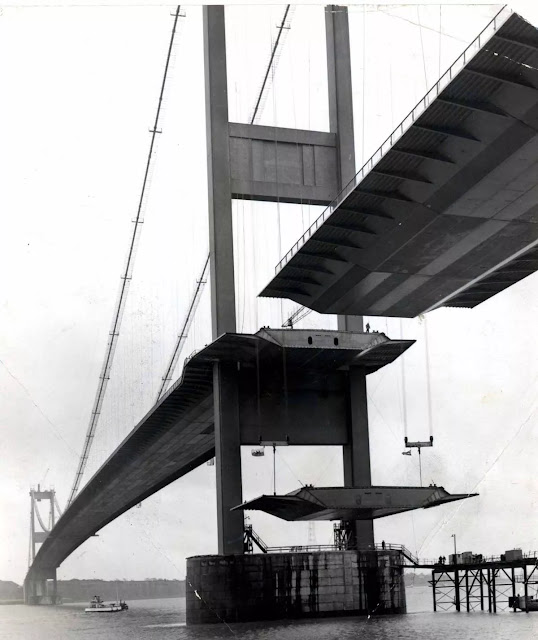This is not the first bridge across the Severn River. The Iron Bridge would have to be earlier. It would be the first bridge near the mouth of the river.
 |
| Street View, Mar 2011 |
 |
| 10th of 22 construction photos in WalesOnline A [130-ton, 40m long] section of the road deck is lifted into place. "From 1966 to 1996, the bridge carried the M4, before the Second Severn Crossing opened." |
 |
| Doug Nethercott posted The Severn Princess at Aust/Beachley ferry shortly before being taken out of service after the building of the Severn Crossing which opened 8 September 1966 when the ferry service then ceased. She had a wheelhouse and funnel in the centre of the car deck and was 77ft x 28ft with twin Leyland diesel engines and could take 19 vehicles and 98-foot passengers. She was launched 23 May, 1959. She was used for many purposes afterwards until she was found wrecked in 1999, abandoned and full of fertiliser in Connemara, Ireland by Dr Richard Jones, the grandson of Enoch Williams. As Galway County Council had put a demolition order on the vessel, a small group of Chepstow residents formed the Severn Princess Restoration Group with an urgent remit to save the Severn Princess and return her to the town. The derelict vessel was purchased for a token 1 guinea and temporary repair work started to get the vessel back to a state where it could be towed back to South Wales. She returned to Beachley in 2003 following a five-day tow and then placed in the hands of the ‘Severn Princess Preservation Trust’ that was set up in 2014 who then became a formal charity in 2019. For some years the vessel rested alongside the Beachley slipway but was eventually moved to the west bank of the River Wye in Chepstow, to sit beneath the railway bridge where it will stay as a permanent heritage display at the site the group have cleared to make the site more attractive to visitors and users of the Wales Coast Path which runs through Chepstow. The Trust hope that their work can lead to a main event at the end of the Wales Coastal Path beside the Wye, with a standing platform beside the Princess so more people can learn about the ferries. Work still continues and the group were happy to report that after 55 years the turntable was back on board and spinning again. In November 2023, she successfully qualified for listing on the National Register of Historic Vessels, making it officially of UK national interest and now joins a prestigious list of more than 1,000 historic vessels, including the Cutty Sark and SS Great Britain. To be considered for listing, the vessel had to be at least 50 years old, have demonstrable and significant UK associations, be based in the UK, be more than 33ft in length and the hull must be substantially intact. |
 |
| Bill Brown's Bridges "Dr William (Bill) Brown was the principal designer working with Sir Gilbert Roberts and the Freeman Fox & Partners team on the Severn Bridge. He is credited with designing the innovative aerodynamic box girder deck, which superseded the complex trusses used on earlier major suspension bridges in the UK (Forth Road Bridge) and the USA. Bridges all over the world are descended from the design and engineering of the Severn Bridge." 987.5m main span 1,839m total length |
 |
| Bill Brown's Bridges I remembered correctly, this bridge used wind-tunnel testing to develop the new box-girder deck shape. But I didn't know that Bill got wind tunnel time because the truss deck that was being tested got destroyed. |
 |
| NationalHighways Blecause it does not have wind barriers, this bridge is closed to traffic if gusts above 40 knots (46mph) are expected. When closed, traffic is diverted to the second bridge. The second bridge, which has wind barriers, can handle traffic up to 70 knots (80mph). Tolls were removed for both bridges in 2018. |
 |
| Bridges Now and Then posted On the UK's first Severn Bridge, c. 1963. (Media Storehouse) Dave Frieder: Footbridge for Main Cable Construction. |
"Unlike most suspension bridges the cables carrying the deck are not vertical but arranged in a zig-zag style. Engineers used this arrangement of cables to reduce vibration. 'Stockbridge dampers' were also used to reduce vibration. The dumb bell-shaped devices suppress vibration caused by wind on overhead power lines by dissipating energy. Engineers decided on the shape of the bridge after extensive wind tunnel testing. Much of the structure was built in Chepstow with sections floated down the river to the construction site and then hoisted into place." [ice]
 |
| HistoryPoints, Photo by Hugh Pritchard "Two concrete piers, 988 metres apart, were built up from the bed of the estuary. The Aust pier rests on a limestone outcrop while the Beachley pier rests on hard mudstone. The bridge’s towers were made of high-tensile steel, weighing 2,700 tons in total." |
 |
| bbc The Severn Bridge in the 1970s This bridge was built at the location of the ferry service that it replaced. |
No comments:
Post a Comment